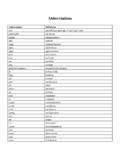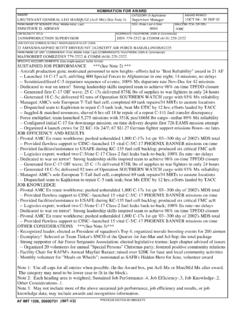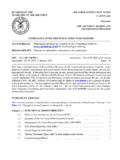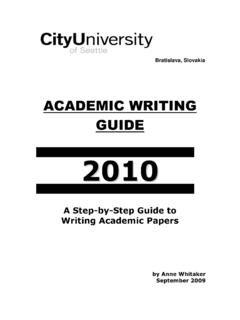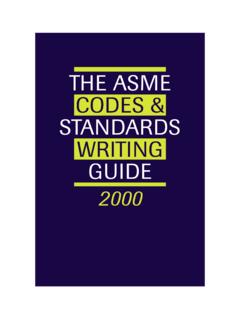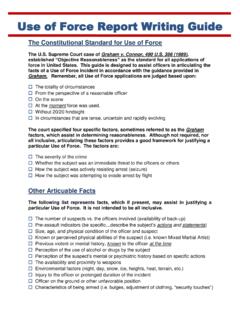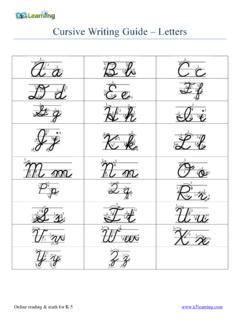Transcription of HQ USAF/SG OPR/EPR/PRF WRITING GUIDE 19 …
1 5 HQ USAF/SG OPR/EPR/PRF WRITING GUIDE 19 June 09 DRAFT Version will go final when revision to AFI 36-2406 (Officer and Enlisted Evaluation Systems) is published later this year. 6 TABLE OF CONTENTS Ref # Subject Page Performance Report Requirements 1 1. Section I Ratee Identification 2 2. Job Description (Section II) 3 3. Performance Factors/Assessment (Section III) 3 4. Rater Overall Assessment (Section IV) 4-5 5. Basics of Bulletology (How to structure and write competitive performance report bullets) 6 Three Parts Of A Good Performance Report Bullet 6 Use Impact-Oriented, Action Words Or Phrases 6 Use SINGLE Bullets--NO Wraparounds 6 Avoid Fluffy, Feel-Good Phrases And Prose 6 Define ALL Acronyms And Abbreviations First Before Using Them 6 White Space Is Not Good 6 Put Impact In Some Kind Of Measurable Terms 6 Level Of Impact Is Also Very Important 7 Community Involvement Bullets 7 Quantification 7 The Use of % and $ Symbols 7 For Money (Not People, Places or Things) 7 For Numbers of People, Places or Things 7 6.
2 Mapping the Bullets: Overall Assessments 8 Section V--Rater Overall Assessment 8 Bullet Order Of Precedence 9 Basic Rules For Top And Bottom Lines 9 OPR Bullets--Last lines 9 Stratification 9 Recommendations 10 Table 1 Appropriate PME Recommendations 10 Consistency is Key 10 EPR Bullets--Last Lines 11 Stratification 11 Recommendations 11 Consistency is Key 11 7 TABLE OF CONTENTS Ref # Subject Page 7. Mediocre Performance Reports 12 White Space 12 Community (non-duty related) Bullets 12 Wraparounds 12 Fluffy Say-Nothing Bullets 12 Last Line Mediocrity 12 8. Mechanics: Includes excerpts from Tongue and Quill (T&Q) 13 Acronyms 13 Use Of Past Tense 13 Matching MILPDS RIP 13 Punctuation Allowed In Bullets 13 Hyphenation Rules 13-16 Capitalization Rules 16-18 Abbreviated Forms Of Wings, Groups and Squadrons 18 Use Of Apostrophes 18 Use Of Commas 18-19 Numbers 19 9.
3 General OPR/EPR Guidance 20 Error Free Reports 20 Timelines 20 Feedback Annotation 20 Common Mistakes in OPRs/EPRs 20 Helpful Hints 21 Report Checklist 21 OPR/EPR Routing 22 10. General PRF Guidance 23 Promotion Recommendation Form (AF Form 709) 23 Promotion Recommendation (Section IV) 24 Example PRFs 26-28 PRF Justification Form 29 APPENDIX 1: Accepted acronyms (these do not need to be defined before using) 30 APPENDIX 2: Commonly used performance report words that are hyphenated 31 APPENDIX 3: Commonly used performance report words that are one word (not hyphenated) 32 APPENDIX 4: Words that should be two (or more) words 33 APPENDIX 5: Hints and Examples 34 APPENDIX 6: Promotion Recommendation Form Tutorial 35-36 APPENDIX 7.
4 Spelling GUIDE 37-42 1 Performance Report Requirements AFI 36-2406, Officer and Enlisted Evaluation Systems Who requires one? When are the performance reports required to be written? Referral Performance Reports When requiredAnnually (365 days) -- AnnualChange of Rater upon 120 calendar days of supervision (CRO)Other reasons: (various between 60 to 120 days depending on reason) Tables or of other rules/reasons (Table for ADAF officers and for ADAF enlisted members)W ho Requires ThemColonel and belowExceptions:1. AB-A1C with < 20 mos in service* 2. Full time student or patient status 3. Death of ratee4. Retirement within 1 year of annual closeout date and retirement application approved prior to projected annual close out date*5. Personnel with approved separation date** other requirements apply for this exception see paragraphs required1.
5 Evaluator marks any "Does not meet standards" block (OPR)2. Any far left mark (EPR)3. Overall rating of "1" (EPR)4. If any comments in report are derogatory in nature5. Reference to any disciplinary actionIncludes: Failure to progress in WMP or FIT and others see para 2 1. Section I Ratee Identification Data Performance Reports are the bread and butter of a career. They are the key documents behind: Medal considerations, Stripes for Exceptional Performers (STEP) promotions, all officer promotions, enlisted promotions, AFIT selection, specialized training assignments and special duty selection. In addition, these documents are key elements in the selection for commanders and Command Chief Master Sergeant positions. The start of this WRITING process includes accurate ratee identification.
6 Most of this data should come directly off the RIP obtained from MILPDS. NAME: The name should always be in all CAPITAL letters. SSN: (the dashes are automatically put in by the program). GRADE: Use pull down menu to select grade. DAFSC: Use what is listed on the RIP as the DAFSC only (this may not be the same as the member s PAFSC). OPR - REASON FOR REPORT: It will most likely be one of three different reasons: Annual, CRO (which signifies change of reporting official) or Directed by HQ USAF. Use pull down menu to select appropriate category. EPR - ORGANIZATION, COMMAND, LOCATION, and COMPONENT: This is done in all CAPITAL nomenclature with no commas. Please note this is the only place where you may deviate from the MILPDS RIP. Where the RIP notes (AF ELEMENTS (OTHER) use the abbreviation OL (ELM) instead (without the markings).)
7 PASCODE: Use the PASCODE from the RIP (again only CAPITAL letters are used). OPR - ORGANIZATION, COMMAND, LOCATION, and COMPENENT. EPR - SRID: Enter Senior Rater ID for the ratee s unit of assignment as of the closeout date. REPORT PERIOD: Use the dates listed on the RIP (if they differ, please annotate the RIP with correct dates). Example, 20 Dec 2008 THRU 19 Dec 2009. NO. DAYS OF SUPERVISION: Ensure the number of days is correct on the RIP. If this is not the case, please annotate the RIP with correct dates. OPR - SRID EPR - REASON FOR REPORT: Use pull-down menu to select reason. 3 2. Job Description (Section II) (Section II -AF Form 707 OPR; Section II AF Form 910/911 EPRs) The key duties, tasks and responsibilities block (job description) needs to have solid quantitative and/or qualitative statements tailored to that person s duty responsibilities.
8 Duty Title is typed in all CAPITAL letters and must match job title on MILPDS RIP, if the duty title has changed, then the change must be annotated on the RIP. The duty title must be completely spelled out (do not use abbreviations or acronyms); do not use a generic title. This area must accurately reflect duties and should show progression over time. Key Duties - Use bullet format only for describing the key duties, responsibilities and tasks--remember to describe major tasks. Use language understood by the entire Air Force. IMPORTANT: Excessive empty (white) space sends a negative message. OPR/EPR limited to four lines of text within this section. Officers may have additional duties included within the last bullet. If they lead or direct a program or area, start the bullet of the job description with those words.
9 Begin bullets with action verbs--manages, leads, directs, conducts, etc. Move levels of personnel supervision and leadership up front and early in the job description. Questions that should be answered in the job description: How many? -- This should include people supervised, places (number of separate sub-divisions overseen in a flight or program) How much? What is the total worth of the equipment/facilities under their purview? What is the square footage of the facility? Comparison to others in MAJCOM/AF/DoD (largest, ). EPR - SIGNIFICANT ADDITIONAL DUTIES: Other official responsibilities of significance outside of primary duties, which are focused toward the mission. 3. Performance Factors/Assessments (Section III) OPR - Select the appropriate box relative to the illustrated Performance Factors.
10 Use the Fitness Exemption pull-down menu to select Yes if the member is exempt to all fitness testing components. See the OPR MPF and Program Guidance MEMO (MPFM: 07-45) for additional information. EPR - Select the appropriate boxes and make necessary comments relative to the illustrated Performance Assessments identified in subsections 1-6 of the AF Form 910 and 1-7 of AF Form 911. Find guidance for completing this section in the EPR MPF and Program Guidance MEMO (MPFM: 07-44). 4 4. Rater Overall Assessment (Section IV) Rater Overall Assessment Section IV - Remember this area is not the job description section--precious space should not be wasted describing the duties. Use action verbs up front or strong, short lead ins. Relate the accomplishment to primary mission Save the biggest wing, MAJCOM, AF, and DoD level bullets for additional rater s in block V Show impact on mission, productivity, leading area of influence (program, division, Region, etc.)
